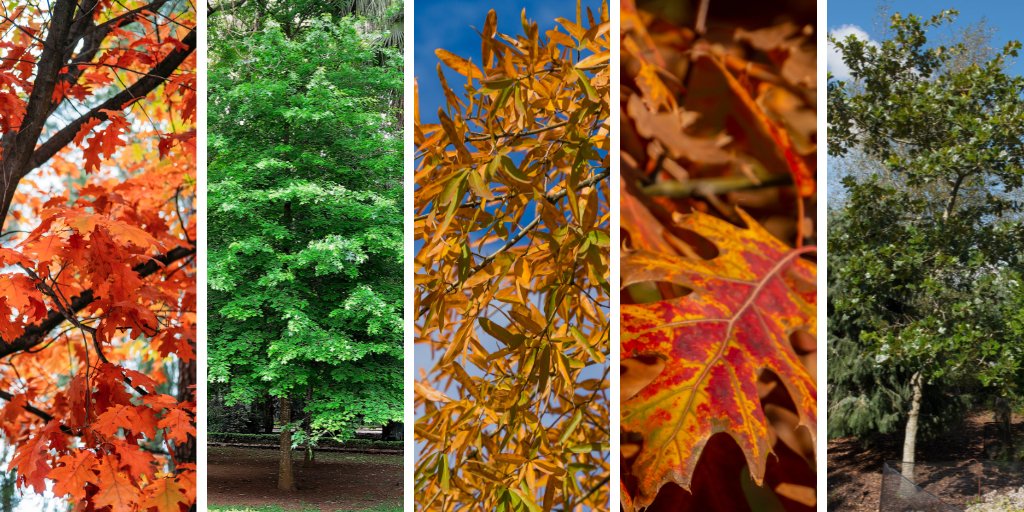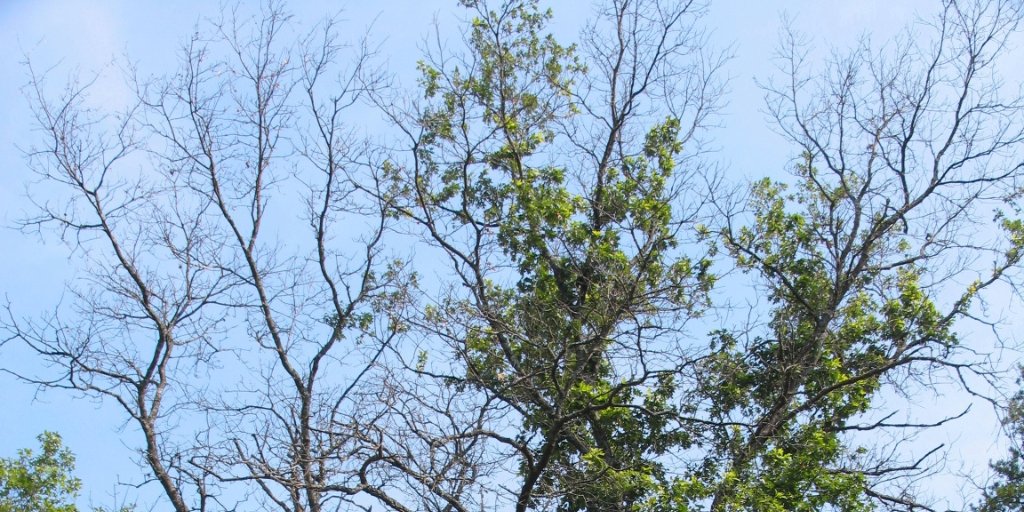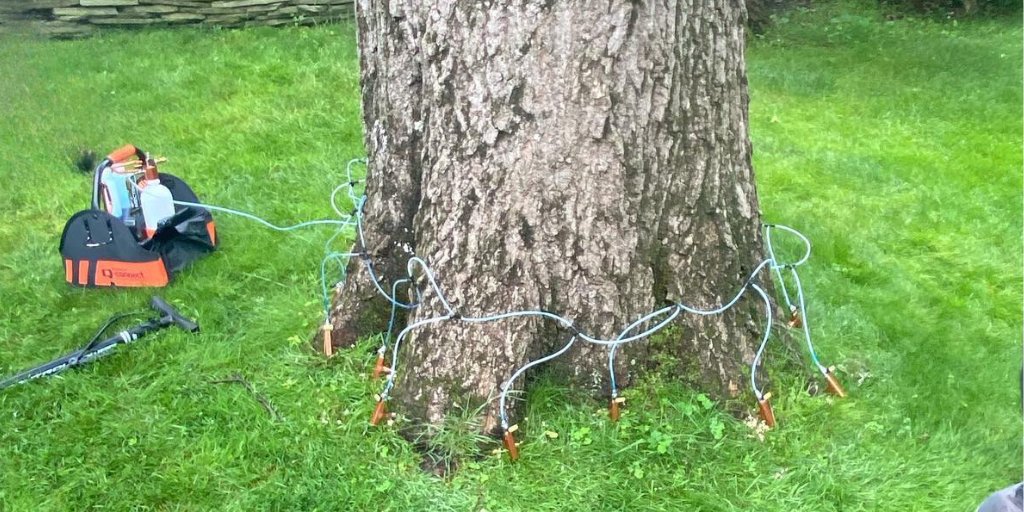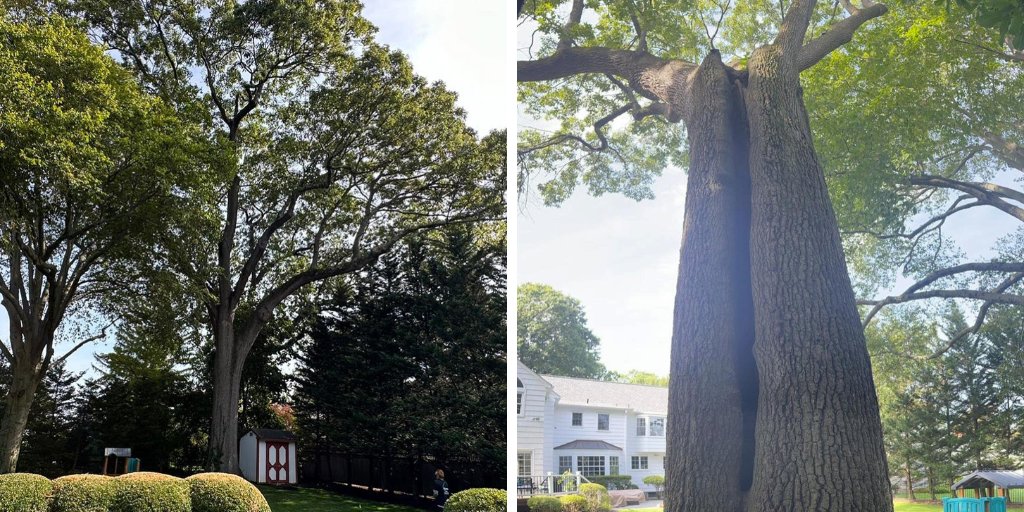With the emerald ash borer destroying most of the ash trees in our area, only a few large tree species, such as oaks, maples, and tulip trees, are left in New Jersey. Caring for and protecting these large trees is important, especially now that our oak trees are under attack from several different diseases.
Oak wilt, bacterial leaf scorch, and hypoxylon canker are diseases currently harming our beautiful New Jersey oak trees.
In this article, we will discuss how to:
- identify if you have any oak trees
- spot the signs of these diseases on your oak trees
- protect your oak trees from pests and diseases
Do You Have an Oak Tree? How To Identify an Oak
Before we delve into the diseases impacting our local oak trees, it’s important to check if any trees on your property are oak trees. There are hundreds of species of oak trees (around 600!), and several types can be found in our area. One of them, the red oak (Quercus rubra), is the New Jersey state tree.
Oak trees native to North America are separated into two groups: red oak species and white oak species.

Trees in the red oak species include (from left to right): red oak, scarlet oak, willow oak, pin oak, and scrub oak.
Red oak species, which have darker bark and leaves with pointed lobes (sometimes called “bristle-tipped”), include:
- Northern red oak (Quercus rubra)
- Southern red oak or Spanish oak (Quercus falcata)
- Scarlet oak (Quercus coccinea)
- Willow oak (Quercus phellos)
- Pin oak or swamp Spanish oak (Quercus palustris)
- Black oak (Quercus velutina)
- Scrub oak or bear oak (Quercus ilicifolia)

Trees in the white oak species include (from left to right): shingle oak, white oak, swamp chestnut oak, chestnut oak, and blackjack oak.
White oak species, which often have lighter bark and leaves with rounded lobes, include:
- Yellow chestnut oak or Chinkapin oak (Quercus muehlengergii)
- Blackjack oak (Quercus marilandica)
- Laurel oak or shingle oak (Quercus imbricaria)
- Swamp chestnut oak or basket oak (Quercus michauxii)
- White oak (Quercus alba)
- Swamp white oak (Quercus bicolor)
- Chestnut oak (Quercus montana)
- Post oak (Quercus stellata)
See detailed information on all the above-listed oak trees >>
The easiest way to recognize an oak tree is by its leaves. Most (but not all) oak trees are deciduous, meaning they will lose their leaves in the fall and grow them again in the spring.
Oak tree foliage turns red in the fall and brown in the winter. Oak trees lose their leaves later in the fall than other trees, and some hold on to the brown leaves until spring, meaning that you can often spot oak trees with brown leaves during the winter months.
Another way to recognize an oak tree is by its acorns, which drop to the ground and provide food for birds and wildlife.
Diseases Impacting Oak Trees in New Jersey
Once you have determined that you have oak trees on your property, the next step is to check for any issues. With at least three diseases currently impacting New Jersey oaks, there is a good chance that your trees may suffer from one, which can significantly decrease their lifespan.

Oak wilt killed this northern red oak tree. Photo courtesy of Joseph Obrien, USDA Forest Service, Bugwood.org.
Oak Wilt
Oak wilt is a fungal disease that threatens all oak species. The pathogen slows and eventually stops the movement of water throughout the tree by infecting the tree’s xylem tissue.
Signs of oak wilt include:
- Leaf drop (leaves dropping to the ground earlier than usual)
- Foliar discoloration (leaves changing color)
- Crown wilting (if the top of your tree seems to sag)
Learn more about oak wilt, how it spreads, and what you can do >>

Bacterial leaf scorch on oak leaves. Photo courtesy of Nancy Gregory, University of Delaware, Bugwood.org.
Bacterial Leaf Scorch (BLS)
Bacterial leaf scorch is a bacterial disease that eventually kills any tree in the “red oak” group. If your oak leaves are bristle-tipped, they are in danger of being impacted by this bacterial disease.
BLS can also impact other trees found in New Jersey, such as sycamores and elms.
The bacteria, Xylella fastidiosa, plugs up the xylem tissue of the tree, preventing water flow to the tree’s crown.
Signs of bacterial leaf scorch include:
- Browning of the leaf margins (the edge of the leaf)
- Premature leaf drop of large portions of the tree’s crown (lots of leaves falling earlier than usual)
Symptoms of bacterial leaf scorch will continue to get worse every year until the tree eventually dies.
Learn more about Bacterial Leaf Scorch >>

Loss of bark, fruiting bodies, and brittle wood are all symptoms of hypoxylon canker on oak trees. Images courtesy of Ronald F. Billings, Texas A&M Forest Service, Bugwood.org, Joseph OBrian, Joseph OBrian, USDA Forest Service, Bugwood.org, and North Carolina Forest Service, Bugwood.org.
Hypoxylon Canker
Hypoxylon canker is a fungal disease affecting all species of oak trees.
Signs of hypoxylon canker include:
- Noticeable crown thinning (fewer leaves on the tree than usual)
- Branch dieback
- Small patches of foliar die out (sections of the tree that have dead leaves)
- Large areas of bark falling off branches and the tree trunk, exposing dusty tan fungal spores.
If the bark falls off and the fungal spores are exposed, they will turn silver or gray, and the wood beneath them will become extremely brittle.
Learn more about hypoxylon canker on oak trees >>

An oak tree in New Jersey receiving preventative treatments from Alpine Tree.
How to Protect Your Oaks
Now that you are familiar with oak trees in New Jersey and some of the diseases plaguing them, learn how to protect your oak trees.
Schedule Oak Health Care Treatments
Alpine Tree provides preventative treatments for oak tree issues, including bacterial leaf scorch and oak wilt. In the photo above, the Alpine Tree team treats an oak tree in New Jersey.
Learn more about our pest and disease management programs >>
Maintain the Health of Your Oak Trees
You can also work to protect your oak trees from pests or diseases, including the fungal and bacterial diseases mentioned above, by properly maintaining them.
That includes scheduling pruning during the dormant season when pests and diseases are less likely to spread.
Keep your trees from stress by ensuring they receive enough water, nutrients, and preventative care.
Regularly check over your trees for signs of any issues, including broken branches, cracks in the bark, or changes to the leaves.
Use organic mulch around your tree to regulate the temperature, retain moisture, and provide nutrients as the organic matter breaks down (just be sure to avoid a mulch volcano.
Schedule deep root fertilization for your trees to ensure they have the nutrients they need to stay healthy.
Alpine Tree Service is here to help you keep your New Jersey oak trees healthy and long-lasting. Contact our office if you have questions about oak trees, tree health, or our tree care services.
Remove Dead or Dying Oaks
If a fungal or bacterial disease has already impacted your oak trees, it is best to remove them as soon as possible to prevent the disease from spreading to other nearby trees.
As some oak issues cause oak trees to become extremely brittle, dead or dying oak trees can become hazardous.
Alpine Tree has the equipment to handle large oak tree removals safely, even if the wood has already become brittle, but we recommend that you remove any diseased oak trees before they reach that point.
Learn more about tree removal services >>

Alpine Tree professionally pruned this beautiful majestic oak tree in New Jersey.
Enjoy Your Oak Trees
Oaks are one of the few remaining large trees growing in New Jersey. Protecting them from issues such as these tree diseases will help them continue to grow and have a long life.
We hope you have found this article on oak trees helpful, but if you have any other questions about your trees in Morris, Essex, Union, or Somerset counties in New Jersey, please don’t hesitate to contact us.




